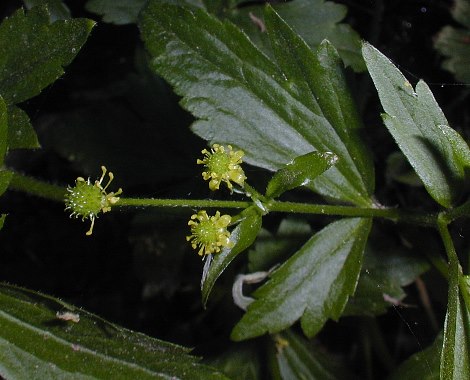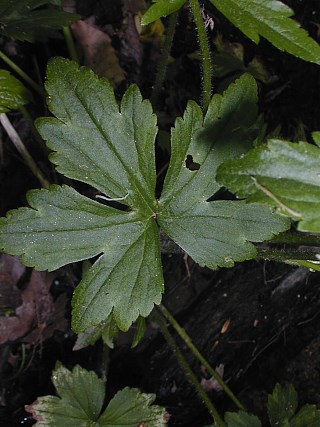Description: This herbaceous perennial plant is about 1-2' tall, consisting of some basal leaves, branched stems with alternate leaves, and flowers. The basal leaves are up to 5" long and 5" across; they have long hairy petioles. Each basal leaf is palmately cleft into 3-5 lobes; these lobes are often divided again into smaller lobes. The alternate leaves are similar to the basal leaves, except they become smaller as they ascend the stems and their petioles are shorter. The upper leaves are more slender and divided into fewer lobes. The margins of the leaves are crenate or dentate. The upper surface of each leaf is medium to dark green and glabrous. The stems are light green, terete, and covered with long hairs; they are erect to ascending, rather than sprawling across the ground.

The upper stems
terminate in loose clusters of flowers. Each flower is about 1/3" (8
mm.)
across, consisting of 5-6 yellow petals, 5 light green sepals, a dense
green cluster of pistils, and a ring of surrounding stamens with yellow
anthers. The petals are oblong-elliptic and a little shorter than the
sepals; the latter tend to hang downward while the flowers are
blooming. The pedicels of the flowers are pubescent. The blooming
period occurs from mid-spring to early summer and lasts about 1 month.
Both sepals and petals are deciduous and they soon fall to the ground.
The pistils become transformed into a dense cluster of flat-sided
achenes with slender hooked beaks; this fruit is globoid in shape.
Eventually, the fruit changes in color from green to nearly black. Each
achene is about 2-3 mm. long. The root system consists of a cluster of
fibrous roots and occasional rhizomes. Sometimes, small clonal
colonies of plants are produced.

Cultivation:
The preference is light to medium shade, wet to moist conditions, and
soil with abundant organic material.
Range & Habitat:
The native Hooked Buttercup is widely distributed in Illinois, but it
is found
only occasional in most areas (see Distribution
Map). Habitats include damp depressions in upland woodlands,
floodplain woodlands, shaded areas along streams, bottoms of rocky
ravines, areas along woodland paths, swamps, forested bogs, and shady
seeps. This species prefers damp woodlands and shaded wetlands.
Faunal Associations:
The nectar of the flowers attracts primarily small bees. These include
Cuckoo bees (Nomada spp.), Halictid bees (Augochlorella
spp., Lasioglossum spp.), and Andrenid
bees (Andrena spp.). Among vertebrate animals, the
Wood Duck, Ruffed Grouse, and Wild Turkey feed on the seeds and foliage
of Ranunculus spp. (Buttercups) in woodlands. The
Eastern Chipmunk also eats the seeds of these plants. Hoofed mammalian
herbivores usually avoid the consumption of buttercups because the
toxic foliage contains a blistering agent that can irritate the mouth
and gastrointestinal tract.
Photographic Location:
Along a stream at the bottom of a rocky ravine at The Portland Arch in
west-central Indiana.
Comments:
This buttercup has achenes with unusually long hooked beaks; this
provides its fruit with a slightly spiny appearance. While its foliage
is reasonably attractive, the flowers are not very showy. Other similar
buttercups include Ranunculus abortivus
(Small-Flowered Buttercup) and Ranunculus pensylvanicus
(Bristly Buttercup), which can be found in wet woodlands as well.
Small-Flowered Buttercup has lower leaves that are kidney-shaped and
lack lobes, while the palmately cleft leaves of Bristly Buttercup have
more narrow lobes. The latter species also blooms later in the year
(during the summer) than Hooked Buttercup. Other similar buttercups
have larger flowers (at least ½" across) or their fruits (seedheads)
are more elongated (ovoid or oblongoid) in shape.